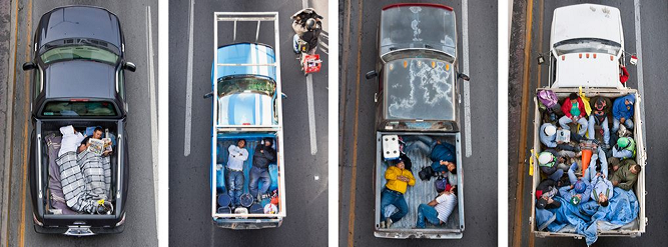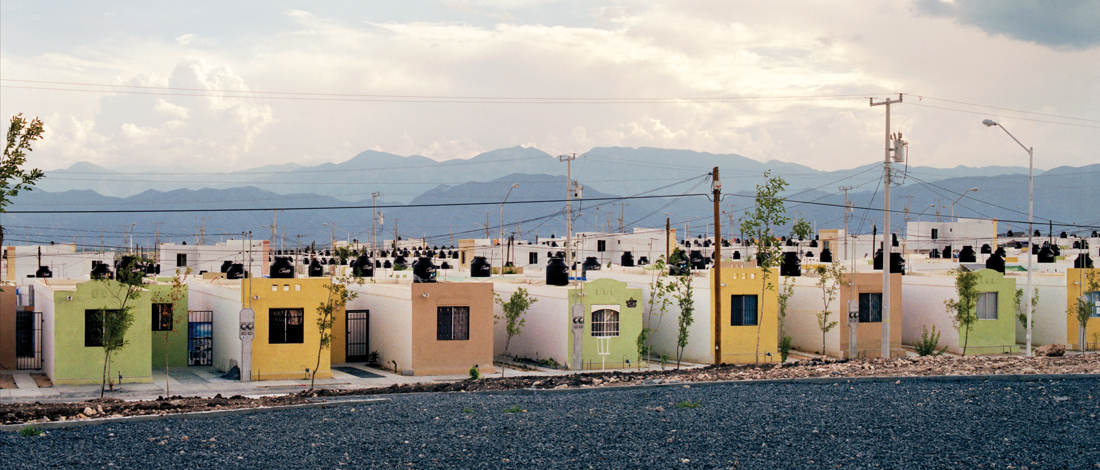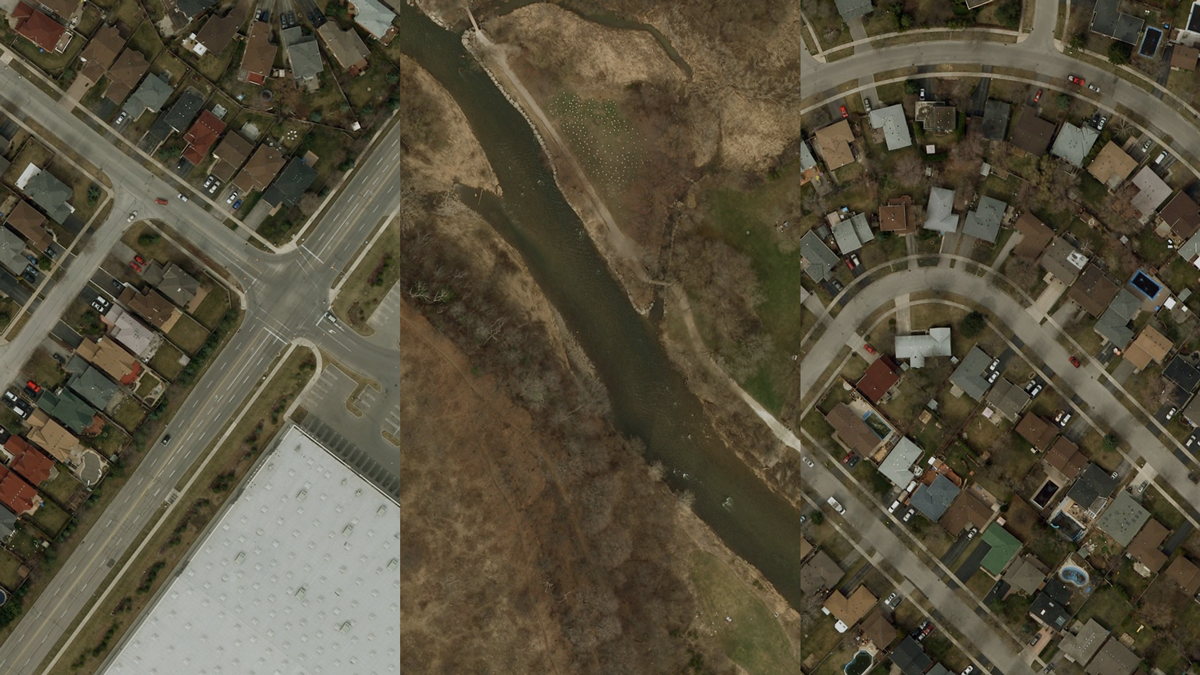Contacting Toronto: Expanding Cities / Alejandro Cartagena, Julia Krolik & Owen Fernley
 Alejandro Cartagena, Carpoolers, 2011. Courtesy of Contacting Toronto
Alejandro Cartagena, Carpoolers, 2011. Courtesy of Contacting Toronto
To understand the cultural phenomenon of urban sprawl, one must consider both the progress and regression that comes with it. While the offer of more space, fresher air and reduced traffic congestion in suburban areas boasts a certain appeal for many, urban city centres still receive greater investment opportunities and consequently offer more growth potential for their residents. However, the tendency to leave behind densely populated cities in favour of the suburbs is often justified and sustained by the prevalence of transit hubs such as major bus and subway stations.
Situated within Warden subway station in Scarborough, the exhibition Contacting Toronto: Expanding Cities explores the geographical, social, and political composition of suburban life, of communities on the periphery and the people who inhabit them, and the seemingly never-ending rows of cookie-cutter homes. Just outside the bounds of Toronto’s eastern limits, Warden station is a marker of hybridity – simultaneously urban and suburban – and serves as a crucial link for tens of thousands of commuters traveling to and from the city on a daily basis. Such transit lines facilitate an aesthetic shift from condominiums to cul de sacs and make car-less commuting a viable option, however it is not a luxury afforded to all people in other parts of the world.
The notion of mobility figures highly within the exhibition, specifically in the work of Mexican photographer Alejandro Cartagena, whose large-scale prints of outlying towns and the workers who build them line the station’s bus bays and subway platforms. Cartagena’s Suburbia Mexicana series (2006–2010) addresses the political and cultural effects of suburban expansion away from municipalities like Monterrey, Mexico’s third largest metropolitan area, and how the construction of less affluent adjoining towns makes living more difficult for the people who come to reside there. The towns featured in Fragmented Cities lack the necessary public transit systems and infrastructure to sustain a fully functioning community, yet property developers continually disregard issues of increased vehicular activity and environmental damage in favour of turning a profit.
 Alejandro Cartagena, Suburbia Mexicana: Fragmented Cities, 2006 – 2010. Courtesy of Contacting Toronto
Alejandro Cartagena, Suburbia Mexicana: Fragmented Cities, 2006 – 2010. Courtesy of Contacting Toronto
Cartagena’s photographs “shed light on the implemented neo-liberal economic strategies made by the Mexican government since 2001 that have pushed urban growth out of the regulation of the metropolitan urban plan,” and this decision by the government to allow the “urbanization” of land outside the bounds of major city centres continues to alienate inhabitants of these regions. Particularly in light of the lingering effects of the recession felt all over the world for the past number of years – from government bailouts to sliding currencies to layoffs by the tens of thousands – there has been a changing economic landscape on a global scale, and yet in certain parts of rural Mexico, money continues to be questionably invested into the building of hundreds of houses with limited surrounding amenities and services. The rows of houses pictured in Fragmented Cities feel frozen in time, as if they are abandoned ghost towns that are no longer functioning. An uncertainty exists whether or not the homes are even occupied, as the deserted streets fail to show any trace of domestication.
However, Cartagena offers his audience a glimpse into the lives of the people who populate towns such as Juarez and Apodaca through People of Suburbia, another sub-series of Suburbia Mexicana. The artist captures images of families enjoying each other’s company outside of their homes, others returning home after a day of shopping or from a night out in Monterrey, and also partaking in activities of leisure and labour. While some portraits communicate the challenges and hard work associated with this lifestyle, others convey happiness and the pride of all that these townspeople do possess.
Cartagena’s recent project, Carpoolers (2011–2012), adds another dimension to the debate surrounding transportation and sustainability, as it depicts the construction workers who build the housing units that make up these isolated suburban towns. The majority of these workers live in the poorer suburbs of Mexico, yet they are the same men who also build homes in wealthier suburban neighbourhoods. In a blur of public and private, the men are candidly seen from above as pickup trucks transport the workers to their respective construction sites – some sprawled haphazardly across the exposed flatbed among a detritus of tools and blankets, while others huddle together in an act of camaraderie to create more space for one another. Cartagena photographed his subjects from the same location and time atop a highway overpass over the course of a year, often showing the same men and boys on their way to work – much like the tens of thousands of commuters crowding together on the TTC each day. Despite the illegality of the Mexican workers’ transportation arrangements, lack of public transit and significant distance between their homes and their jobs leave the workers with little choice; when faced with the reality of an ongoing drug war ravaging northern Mexico, a minor moving violation seems well worth the risk in order to make an honest living for their families.
 Julia Krolik & Owen Fernley, Intersection, 2015. Courtesy of Contacting Toronto
Julia Krolik & Owen Fernley, Intersection, 2015. Courtesy of Contacting Toronto
The changing landscape experienced by the carpoolers on their commute finds parallels with the work of Kingston, Ontario duo Julia Krolik and Owen Fernley, whose video series emphasizes a clockwork repetition across various suburban landscapes. Winner of the “Canadian Urbanism Award” at the Toronto Urban Film Festival in 2014, Intersection (2015) appropriates (with permission) Ministry of Natural Resources’ orthophotography of suburban areas north of the GTA (Greater Toronto Area). In a new iteration of an ongoing project, the artists programmed a glitch using HTML5 code to overlay images across one another in a flickering succession of seemingly identical geometric topographies. The project draws similarities with the technology of Google Earth, a virtually endless database of map-like images captured via satellite, and while Krolik and Fernley’s own potential combinations amount to over three million unique variations, the random selection of images nevertheless produces a highly uniform result consistent with the virtually identical roads, parking lots and homes across the suburbs of the GTA.
Playing on a loop across subway platform screens throughout the station, Intersection functions exactly as its name suggests; Krolik and Fernley’s representation of suburban Ontario brings the outside environs into Warden station, while Cartagena’s representations of suburban Mexico suggest what is lacking in terms of development, sustainability and transportation. “Some cities make you lose your head, endless suburbs stretched out thin and dead,” a line from Arcade Fire’s “Wasted Hours” off of their 2010 album The Suburbs, aptly describes this pervasive phenomenon of (sub)urban sprawl, at once both alleviatory and restrictive. Rural expanses become less and less visible as townhouse developments expand into the periphery of large metropolitan areas and dominate the landscape, blurring any distinguishing features that may have once existed in favour of a new field of homogeny. However, a “blandscape” is much less of a concern than lacking infrastructure and community resources.
Warden station serves as a reminder for what could one day be implemented between Mexico’s major urban centres and their neighbouring suburbs, in the hope of serving communities better and providing them with the tools to become self-sustaining.
Nives Hajdin
*Exhibition information: PATTISON Onestop and Art for Commuters present Contacting Toronto: Expanding Cities, featuring noted Mexican artist, Alejandro Cartagena’s images on 55 advertising posters, converting Toronto’s Warden subway station into a distinctive exhibition space from May 1 to 31, 2015. Curated by Sharon Switzer. Contacting Toronto: Expanding Cities is co-produced by PATTISON Onestop and Art for Commuters, in partnership with Scotiabank CONTACT Photography Festival, with financial support from the Ontario Arts Council and PATTISON Outdoor’s Art in Transit program.
